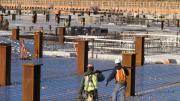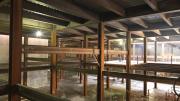Bowing to financial reality, the University announced today that, as expected, it will not continue constructing its huge science facility in Allston—the first development in what had been ambitiously envisioned as a massive campus expansion during the next half century. Moreover, and perhaps surprisingly, Harvard is in effect rebooting its planning effort for that expansion overall, implying a longer deferral of Allston development—and raising the prospect of significant changes from the prior vision of new homes for Harvard School of Public Health (HSPH) and Harvard Graduate School of Education (HGSE), a cultural and performing-arts complex, additional and expansive laboratories, new undergraduate residences, relocated athletic buildings, and other facilities.
The formal notification came in a letter from President Drew Faust. The news office also posted an interview with executive vice president Katie Lapp, who oversees Allston work. The University's Allston development and information site is here.
Allston Science Complex Paused
Addressing the science facility first, Faust wrote that the University “will pause construction” after completing current work in early spring. Significantly, the letter gave no projected duration for the “pause,” and introduced a new wrinkle: continued analysis of “strategies for resumed activity, including co-development.” This suggests that Harvard is exploring options for a partnership with private investor-developers, local research-oriented hospitals, other institutional users of laboratory space, or pharmaceutical companies (which have made large investments in research facilities in Cambridge and the Longwood Medical Area in the past several years).
These options are more conservative than those announced last February, when Faust made public the decision to review construction on the project, then estimated to cost $1.3 billion to $1.4 billion. That decision was made when it became clear that the financial crisis would severely erode the value of the endowment, as well as curtail Harvard’s ability to borrow funds for capital projects, at least not without impairing its top credit rating. (The latter is not an idle risk. The ratings of Cal Tech, Dartmouth, and Rockefeller University have been downgraded this year. For Harvard, a lower rating would raise borrowing costs, possibly make large interest-rate-swaps more expensive, and perhaps hamper some endowment investment strategies.)
In that February 2009 announcement, Faust said the science facility’s foundation would be brought up to the surface level—representing perhaps 30 percent of the construction cost—but that purchases of materials needed to build the four laboratories themselves would be deferred. In the meantime, Harvard would undertake a thorough review of the project’s overall scope and pace. The options, Faust said in her statement then, included proceeding as originally planned (if economic conditions improved rapidly); reconfiguring the building “in ways that yield either new cost savings or new space realization”; and pausing construction completely. The first option is obviously moot. The second—redesigning the facility—is now contingent on the interests and needs of a possible co-developer, whose space requirements would have to be accommodated, and are to be determined. Hence, construction pauses indefinitely, and a search for a new future for the structure begins.
The decision to “pause” and search for partners to restart the project reflects both the known financial realities—economic conditions and prospective endowment returns remain under pressure—and various adjustments the University has made in the intervening months. The scientists who were to have been based at the Allston complex are now being provided for elsewhere: stem-cell researchers are headed for Cambridge; bioengineering scientists are bound for Cambridge and the Longwood medical area; and Medical School’s systems biology department will remain in place in Longwood. Those decisions have two consequences:
• It is expensive—certainly in the several tens of millions of dollars, and possibly more—to refit existing laboratories for the scientists diverted from Allston, and to relocate other professors to accommodate these moves. It is unlikely that the University would want to incur those large costs again, soon, and undo the moves now being made, simply to gather the stem-cell, bioengineering, and systems-biology staffs in Allston.
• The faculty ranks are about to shrink, or to grow much more slowly, in light of retirement-incentive offers and the decision to reduce new professorial appointments to below the replacement level, at least within the Faculty of Arts and Sciences. The overhead funds paid along with sponsored-research grants are an important source of defraying the capital costs of laboratory buildings and facilities. With scientists diverted from Allston, and growth in their ranks slowed, the population of principal investigators whose grant awards would help pay the indirect costs of building and fitting up their laboratories will be smaller, making it harder to cover debt costs that Harvard would have to incur to erect the new Allston facilities. Faust’s letter says that “Harvard’s significant momentum in the life sciences” will “in no way” be slowed by the delay in the Allston science complex, and that faculty recruiting will continue. But the trajectory has clearly changed.
According to the Lapp interview, "The Harvard Corporation voted Monday [Dec. 7] to pause construction at the end of the current phase, and to pursue later phases after we’ve gotten advice on possible alternative approaches to completion, and perhaps changes to the current design. We expect to take the next year to look at possible opportunities, including co-development with private partners or other institutional partners that may make sense for that site, as well as for other Allston sites that Harvard owns." The last phrase points to the larger Allston program.
Allston Campus Planning and Development
Broader “campus development,” Faust’s letter says, “will be pursued as resources allow and only after a targeted, evaluative process” that is about to begin. The University “will meet its obligations to file an updated Institutional Master Plan before its current plan expires in 2012.”
In effect, this means that translating Harvard’s broad Allston vision—the new HSPH and HGSE campuses, and so on—into actual zoning and Boston’s regulatory review process—will take more time, and will likely involve changes, perhaps significant, from the internal planning work done so far. Harvard’s planners have developed an outline for new roads, infrastructure, green spaces, and broad quadrants for prospective uses of its landholdings in Allston (academic buildings, laboratories, cultural facilities, and so on); as guidelines, those appear to be intact. But apart from the now-suspended science complex, none of the outlined objectives for actual buildings or development of the land exist in the form of committed users of the space, nor concrete proposals for architectural design or ensuing development.
Now, a new Work Team--Coleman professor of financial management Peter Tufano, who is senior associate dean for planning and University affairs at Harvard Business School; Institute of Politics head Bill Purcell, the former mayor of Nashville; and professor in practice of urban planning and design Alex Krieger, chair of the department of urban planning and design at the Graduate School of Design--“will recommend strategies for achieving our shared vision of a cohesive scientific, academic, and learning campus environment situated in a sustainable and livable community in Allston.”
Of note, that team--reporting through the executive vice president--will coordinate the work of Faust, the provost, and the deans “to understand the priorities of the University and the schools over the next decade and will recommend ways in which the University’s growth needs can best be addressed, structurally as well as financially.” That time horizon—the next 10 years—suggests a foreshortening of planning, but also, perhaps, a more realistic grasp of what can actually be achieved.
But its suggestion that University priorities need to be reassessed and ranked means that Allston development is only a piece of the puzzle. When HSPH was identified as a tenant for Allston, for instance, its facilities and capital needs were then estimated to exceed a half-billion dollars; whether that figure is meaningful or not, Harvard planners are now evidently going to revisit every school’s facility needs, how these could be met, and where--with costly development in Allston, where infrastructure would have to be created in advance of much academic building, only one among contending priorities. As Lapp said in the interview, "Allston planning going forward will be fully integrated into University planning, keeping in mind not only our programmatic needs, but our holdings in Longwood, Allston, and Cambridge. This is an opportunity for us to think about our campus in holistic and strategic ways."
(Also looming are decisions on how to proceed on the renovation and reconstruction of the now-mothballed Fogg Art Museum, previously estimated to cost $350 million to $400 million, and on the renovation of the undergraduate residential Houses, another billion-dollar-plus program. With the most ambitious Allston plans pushed well off into the future, and a broader review of capital needs in place, it may also be easier for the University to plan and proceed toward a feasible, and long-deferred, fundraising campaign, freed from the complications and formidable costs of aggressive new campus development there.)
And as Lapp suggested, there are indications that the landholdings in Allston themselves are being re-evaluated. The “co-development” process involving the science complex applies generally, suggesting a broad review that might result in private or institutional development of Harvard holdings, sale of land or properties, or any other conceivable option for use, now or in the future.
One critical parcel, the Charlesview housing project, is still in play. Harvard has offered a parcel farther down Western Avenue to which the housing could be relocated; Boston authorities are reviewing that proposal, with a decision expected as soon as next week. Harvard would then buy the existing site, at the corner of North Harvard Street and Western Avenue, helping to defray the costs of building the new housing, while securing a key site at the center of the Allston campus expansion when and as it does occur.
Community Concerns
These decisions may not wholly surprise the Allston community, but they are nonetheless likely to be greeted with dismay in some quarters. The community has participated in hundreds of hours of meetings with Harvard and Boston officials during the past several years, as plans have been drafted and revised.
Faust’s letter addresses “property stewardship and community engagement” and “campus planning and greening.” For the former, she writes, Harvard will make more of the buildings it owns available for re-leasing, to bring life back to local streets. Property leasing proceeded slowly when Harvard offered short lease terms (one to five years); it will now offer 10-year leases on up to 100,000 square feet of space--an indication, of course, that their use for Harvard-related construction and redevelopment is now much longer off in the future. As for “greening,” this involves landscaping, tree planting, and completion of a park behind the Allston public library branch.
As recently as December 9, Harry E. Mattison, an outspoken critic of Harvard’s progress in developing Allston and of the redesigned Charlesview complex, contributed an op-ed to the Crimson, assailing a prospective “easy decision…to do nothing” now. He advocated prompt private development, interim farming use of some of the land, construction of faculty housing, and other uses. He and others will likely be disappointed about today’s announcement, to say the least. On the other hand, it makes it possible that private or non-Harvard institutional investment may advance some uses of the University’s landholdings in Allston faster than the University can now afford to do on its own.









